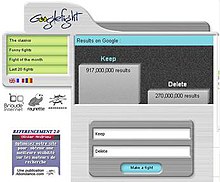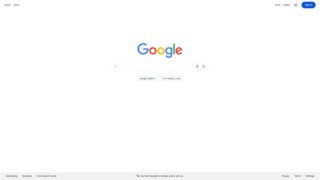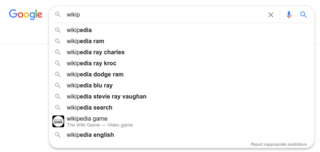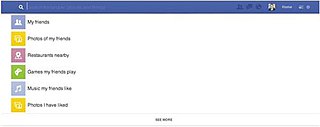
Googlefight was a website that output a comparison of the number of search results returned by Google for two queries, presented as the result of a fight. It was a project of Abondance, the company of Olivier Andrieu. [1]

Googlefight was a website that output a comparison of the number of search results returned by Google for two queries, presented as the result of a fight. It was a project of Abondance, the company of Olivier Andrieu. [1]
Googlefight was developed by Andrieu with two friends. [2] The results of comparing two Google searches are presented as a bar graph using animated HTML segments, presented as the outcome of a fight. Historically the results were displayed graphically in a mixed Flash and JavaScript animation, with two animated stick figures fighting on screen after the queries are entered and before an animated bar graph appeared showing the results. [3] The stick figure animation had no impact on the results.
Between 15 and 27 June 2015, the website was updated to a new version, designed by Andrieu, which the About page stated was powered by Semrush and took into account Google search volume as well as the number of results returned. [2]
The site also expanded in 2015 from French and English versions to 11 geographic versions, including German, Italian, Spanish, and Belgian. [4]
The site is used for entertainment, for example comparing Microsoft and Google, with Google the winner. [5] The results may be comforting, funny or self-referential. [6] [7] It has been used to check spellings. [8] It can also be used as a measure of competitiveness; Salam Pax posted a Googlefight result between himself and Raed Jarrar on their blog in 2002, as their worldwide readership rose in the prelude to the 2003 invasion of Iraq. [9]
Googlefight has been highlighted as an example of a site making money from contextual advertising, as well as one that derives its longevity from community participation (in this case, the always changing search terms). [10]

Google Search is a search engine operated by Google. It allows users to search for information on the Internet by entering keywords or phrases. Google Search uses algorithms to analyze and rank websites based on their relevance to the search query. It is the most popular search engine worldwide.

Salam Pax is the pseudonym of Salam Abdulmunem, aka Salam al-Janabi, under which he became the "most famous blogger in the world" during and after the 2003 invasion of Iraq. Along with a massive readership, his site "Where is Raed?" received notable media attention. The pseudonym consists of the word for "peace" in Arabic (salām) and in Latin (pax). His was one of the first instances of an individual's blog having a wide audience and impact.
Google AdSense is a program run by Google through which website publishers in the Google Network of content sites serve text, images, video, or interactive media advertisements that are targeted to the site content and audience. These advertisements are administered, sorted, and maintained by Google. They can generate revenue on either a per-click or per-impression basis. Google beta-tested a cost-per-action service, but discontinued it in October 2008 in favor of a DoubleClick offering. In Q1 2014, Google earned US$3.4 billion, or 22% of total revenue, through Google AdSense. AdSense is a participant in the AdChoices program, so AdSense ads typically include the triangle-shaped AdChoices icon. This program also operates on HTTP cookies. In 2021, over 38.3 million websites use AdSense.

A stick figure, or stick man, is a very simple drawing of a person composed of a few lines and a circle. Often drawn by children, stick figures are known for their simplistic style. The head is most often represented by a circle, which can be a solid color or embellished with details such as eyes, a mouth, or hair. The arms, legs, torso, and abdomen are usually represented with straight lines. Details such as hands, feet, and a neck may be present or absent; simpler stick figures often display an ambiguous emotional expression or disproportionate limbs.
Quartz Composer is a node graph system provided as part of the Xcode development environment in macOS for processing and rendering graphical data. It is capable of making sophisticated animations for keynote or presentations, and creating animated screensavers.

A search engine is a software system that provides hyperlinks to web pages and other relevant information on the Web in response to a user's query. The user inputs a query within a web browser or a mobile app, and the search results are often a list of hyperlinks, accompanied by textual summaries and images. Users also have the option of limiting the search to a specific type of results, such as images, videos, or news.

Microsoft Bing, commonly referred to as Bing, is a search engine owned and operated by Microsoft. The service traces its roots back to Microsoft's earlier search engines, including MSN Search, Windows Live Search, and Live Search. Bing offers a broad spectrum of search services, encompassing web, video, image, and map search products, all developed using ASP.NET.
A search engine results page (SERP) is a webpage that is displayed by a search engine in response to a query by a user. The main component of a SERP is the listing of results that are returned by the search engine in response to a keyword query.
Keyword research is a practice search engine optimization (SEO) professionals use to find and analyze search terms that users enter into search engines when looking for products, services, or general information. Keywords are related to search queries.

Pivot Animator is a freeware application that allows users to create stick-figure and sprite animations, and save them in the animated GIF format for use on web pages and the AVI format.
Google Search Console is a web service by Google which allows webmasters to check indexing status, search queries, crawling errors and optimize visibility of their websites.
Yandex Search is a search engine owned by the company Yandex, based in Russia. In January 2015, Yandex Search generated 51.2% of all of the search traffic in Russia according to LiveInternet.
Google's Google Panda is a major change to the company's search results ranking algorithm that was first released in February 2011. The change aimed to lower the rank of "low-quality sites" or "thin sites", in particular "content farms", and return higher-quality sites near the top of the search results.

Google Swiffy was a web-based tool developed by Google that converted SWF files to HTML5. Its main goal was to display Flash contents on devices that do not support Flash, such as iPhone, iPad, and Android Tablets. Swiffy was shut down July 1, 2016.
Google Penguin was a codename for a Google algorithm update that was first announced on April 24, 2012. The update was aimed at decreasing search engine rankings of websites that violate Google's Webmaster Guidelines by using now declared Grey Hat SEM techniques involved in increasing artificially the ranking of a webpage by manipulating the number of links pointing to the page. Such tactics are commonly described as link schemes. According to Google's John Mueller, as of 2013, Google announced all updates to the Penguin filter to the public.

The Google Knowledge Graph is a knowledge base from which Google serves relevant information in an infobox beside its search results. This allows the user to see the answer in a glance, as an instant answer. The data is generated automatically from a variety of sources, covering places, people, businesses, and more.

Facebook Graph Search was a semantic search engine that Facebook introduced in March 2013. It was designed to give answers to user natural language queries rather than a list of links. The name refers to the social graph nature of Facebook, which maps the relationships among users. The Graph Search feature combined the big data acquired from its over one billion users and external data into a search engine providing user-specific search results. In a presentation headed by Facebook CEO Mark Zuckerberg, it was announced that the Graph Search algorithm finds information from within a user's network of friends. Microsoft's Bing search engine provided additional results. In July it was made available to all users using the U.S. English version of Facebook. After being made less publicly visible starting December 2014, the original Graph Search was almost entirely deprecated in June 2019.

Vyond is an American cloud-based animated video creation platform created by Alvin Hung in 2007 and developed by the San Mateo, California-based GoAnimate, Inc.
Google Kythe is a source code indexer and cross-referencer for code comprehension which describes itself as a "pluggable, (mostly) language-agnostic ecosystem for building tools that work with code".
Datacommons.org is an open knowledge graph hosted by Google that provides a unified view across multiple public datasets, combining economic, scientific and other open datasets into an integrated data graph. The Datacommons.org site was launched in May 2018 with an initial dataset consisting of fact-checking data published in Schema.org "ClaimReview" format by several fact checkers from the International Fact-Checking Network. Google has worked with partners including the United States Census, the World Bank, and US Bureau of Labor Statistics to populate the repository, which also hosts data from Wikipedia, the National Oceanic and Atmospheric Administration and the Federal Bureau of Investigation. The service expanded during 2019 to include an RDF-style Knowledge Graph populated from a number of largely statistical open datasets. The service was announced to a wider audience in 2019. In 2020 the service improved its coverage of non-US datasets, while also increasing its coverage of bioinformatics and coronavirus.
Googlefight was originally designed by several friends (Sébastien, Frank and Olivier). This new version is conceived by Olivier.
I occasionally use Googlefight to check the more commonly used spelling of a word.